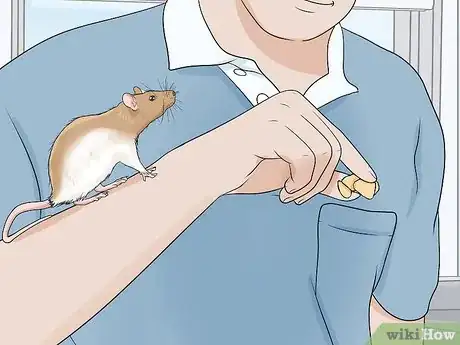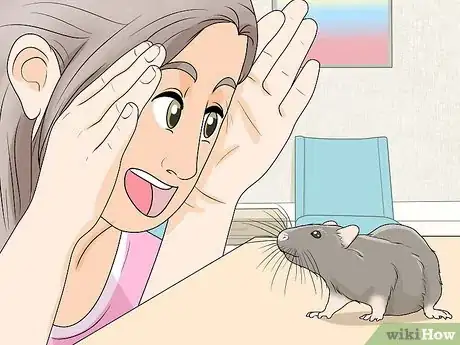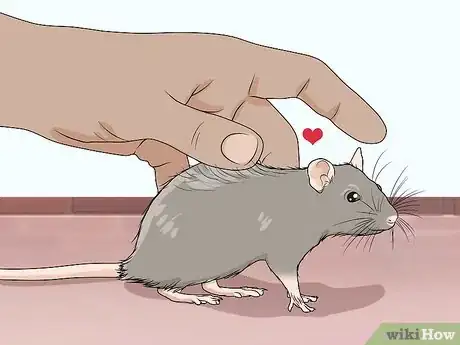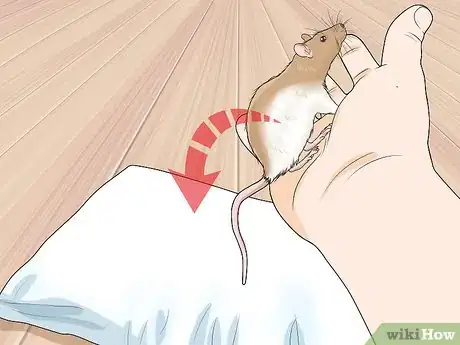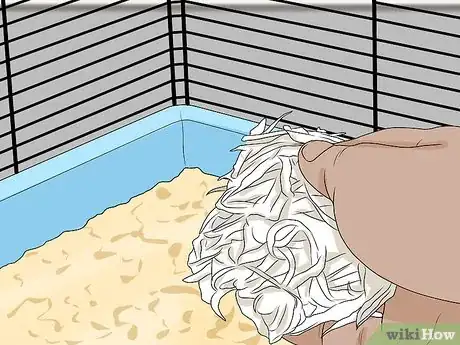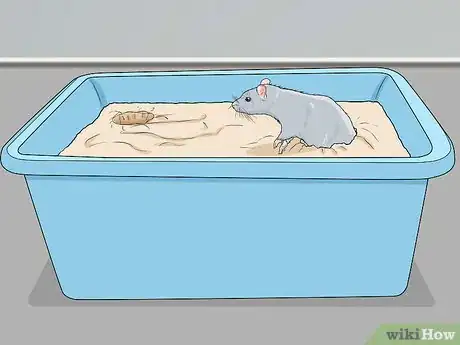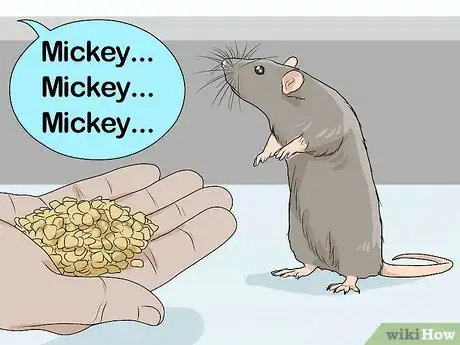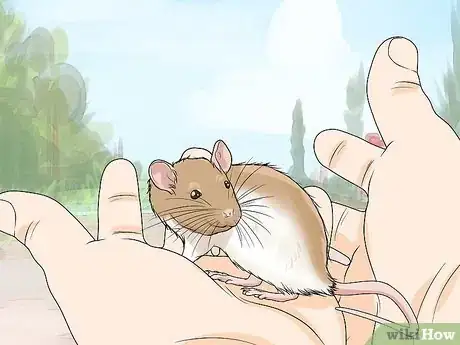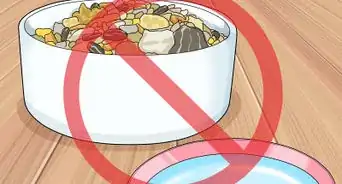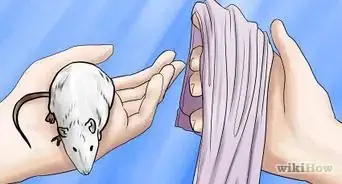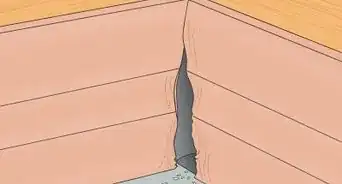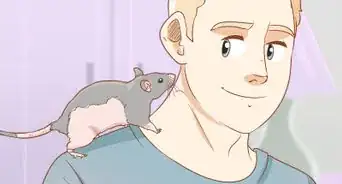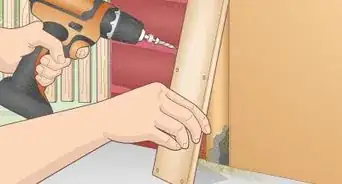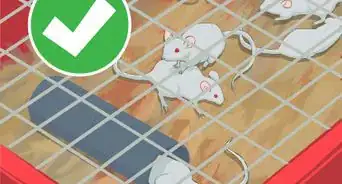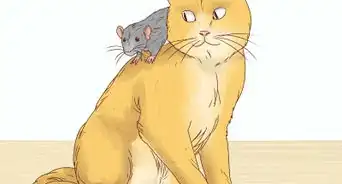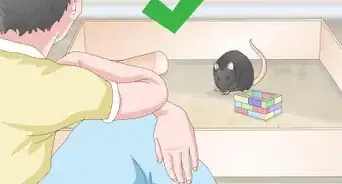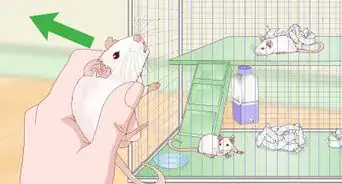This article was co-authored by Pippa Elliott, MRCVS. Dr. Elliott, BVMS, MRCVS is a veterinarian with over 30 years of experience in veterinary surgery and companion animal practice. She graduated from the University of Glasgow in 1987 with a degree in veterinary medicine and surgery. She has worked at the same animal clinic in her hometown for over 20 years.
There are 7 references cited in this article, which can be found at the bottom of the page.
This article has been viewed 33,104 times.
Rats are really intellegent creatures and enjoy lots of play time. It is important that you play with your rats, otherwise they get bored, and may bite you gently. This article will help you with ideas to play, and keep your rats busy.
Steps
Spending Quality Time with Your Rat
-
1Hide treats for your rat to find. Stash small pieces of food in your pockets or the folds of your clothing and let your rat search for them. They’ll have a ball clamoring all over you to try to sniff out the tasty morsels.
- Fruits and veggies such as peas, carrots, potatoes, squash, strawberries, grapes, and apples, along with items like whole nuts and seeds, make great treats for domesticated rats.[1]
- You can also use strips of colored paper or small shiny objects to tantalize your pet rat if you’ve already fed it for the day.
-
2Play peek-a-boo with your rat. Set your rat directly across from you on the floor or a tabletop, then quickly duck out of sight. It will scamper around excitedly when you suddenly reappear. Change up your hiding place every so often to keep it guessing.[2]
- Your rat may come looking for you if it becomes curious enough, turning it into a game of hide-and-seek.
- Peek-a-boo is a fun and simple way to interact with your rat at any time, whether it’s in or out of its cage.
Advertisement -
3Show your rat some affection. Set aside a few minutes each day to make your pet feel loved. Stroke its fur slowly or turn it over and rub its belly with the pads of your fingers. Some rats also love a good scratch behind the ears, under the chin, or just above the tail. All of them relish physical contact and attention.[3]
- Hold your rat close to you while you pet it. Being able to feel the warmth of your body will help it relax and strengthen your bond.
- If your rat is extra happy, it may even return your affection by licking you like a dog!
-
4Wrestle with your rat. Gently push, grab, and roll your rat over, or pretend that your hand is another rat and chase it around. This is a great way to help your pet work off excess energy. Don’t forget to let it win every now and then![4]
- Be careful not to get too rough. Rats are delicate creatures, and you could accidentally hurt them if you use too much force.
- If your rat begins moving frantically or appears overstimulated, put it back in its cage until it calms down.[5]
-
5Toss your rat onto a cushioned surface. Pick your rat up and drop it onto a pillow or mound of blankets from a short distance. Chances are, it’ll come scurrying back for more. It may sound strange, but rats enjoy getting thrown around a little, similar to puppies and kittens.
- Try to make sure your rodent buddy lands on its feet to avoid a bumpy landing.
Keeping Your Rat Occupied in its Cage
-
1Fill your rat’s cage with toys. Toys for rodents come in all kinds of different forms, from running wheels and tunnel blocks to ropes and rubber chew toys for nibbling. A couple of these toys can provide your pet with hours of entertainment. Best of all, they’ll fit right inside your rat’s cage without taking up too much space.
- A hanging ball feeder can double as both a source of food and an engaging plaything.
- If you don’t feel like making a trip to the pet store, try making your own toys out of materials like discarded cardboard, plastic drink bottles, and PVC pipe.[6]
- Make sure to switch out your rat’s toys on a regular basis so that they will always have something different to play with.
-
2Set up a maze or obstacle course. Use small cardboard tubes and boxes to build structures for your rat to explore. You’ll be amazed by how long it will amuse itself by crawling, climbing, and finding new ways to overcome obstacles.[7]
- Stack flat materials on top of one another to create multi-level structures.
- Empty product packages are perfect for converting into tunnels and chambers.[8]
-
3Place some shredded paper in your rat’s cage. Tear up a paper towel or shopping bag and drop the pieces into your rat’s cage. It will quickly get to work finding hiding places for them.[9]
- If you don’t feel like shredding paper for hours on end, simply leave a box of tissues inside your rat’s cage for it to busy itself with.
- Giving your rat a few bits of paper to horde will make it feel like you’re sharing your treasures with it.[10]
-
4Make a digging box for your rat. Fill a small container with sterile potting soil and place it in one corner of your rat’s cage. Digging is so much fun for rats that they’ll often forget about everything else around them.[11]
- Bury tiny toys and treats in the container and send your rat on a scavenger hunt.
- Your rat will be pretty dirty when it’s done playing. It may be a good idea to give it a bath before holding it or letting it run around your home.
-
5Give your rat a friend to play with. Get a second (or more) rat to keep your pet company. Rats are very social creatures and need cagemates. Even if you played with them all day they would still need another rat.
Playing with Your Rat Outside its Cage
-
1Teach your rat to come when called. Set your rat down a few paces away and coax it toward you with a handful of treat while saying its name repeatedly. Once it reaches you, reward it with a treat and belly scratch. After a few attempts, it should begin to respond consistently, even without the promise of a treat.[13]
- Move your hand a little further away each time so you rat has more distance to travel. Eventually, it will learn to come to you from all the way across the room.[14]
-
2Create a play environment in a closed-off area. Take your rat to an open room where it can run around to its heart’s content. Keep the door to the room closed at all times while your pet is playing, and be sure to block off access to electrical outlets and air vents to protect it from harm.[15]
- This can be a good opportunity to play a few of your rat’s favorite games, like chase or hide and seek.
- If you have other pets, make sure they’re crated or secured in another room while your rat is out and about.
-
3Let your rat roam freely when you’re too busy to play. If your rat is well-behaved, you may be able to simply turn it loose and trust it to stay nearby while you’re working, studying, or watching TV. Trained and older rats tend to be especially reliable, and usually won’t venture too far from your side.
- Try not to ignore your rat for too long. Take a break every now and then to see what it’s up to and show it some attention.
-
4Take your rat outside for some fresh air. Place your furry friend in a carrier or simply hold it in both hands while you go for a stroll. Remember, rats are wild animals, so it’s important for them to spend time in their natural habitat. Just be careful not to let your pet get loose, or you may never see it again![16]
- Petting your rat gently while your walk will help keep it calm and prevent it from trying to struggle free.
- If you’re handy with building materials, you might be able to section off a part of your yard to keep your rat contained while it frolics outdoors.
Warnings
- Rats are very sweet, docile animals, but they may bite or display aggression on occasion if you play too rough.⧼thumbs_response⧽
Things You’ll Need
- Rat treats or veterinarian-approved foods
- Toys
- Shredded paper
- Containers of various sizes
- Sterile potting soil
- Pet carrier (optional)
References
- ↑ https://www.thesprucepets.com/feeding-pet-rats-1238500
- ↑ http://animals.mom.me/games-play-rats-4301.html
- ↑ http://www.petrats.org/why_rats.aspx
- ↑ http://animals.mom.me/games-play-rats-4301.html
- ↑ https://www.petplace.com/article/small-mammals/general/having-fun-with-your-rat/
- ↑ http://www.ratsauce.com/rat-toys-and-games
- ↑ http://animals.mom.me/games-play-rats-4301.html
- ↑ http://www.ratsauce.com/rat-toys-and-games
- ↑ http://ratguide.com/care/behavior/training_playtime.php
- ↑ http://animals.mom.me/games-play-rats-4301.html
- ↑ http://animals.mom.me/games-play-rats-4301.html
- ↑ http://ratguide.com/care/behavior/training_playtime.php
- ↑ http://ratguide.com/care/behavior/training_playtime.php
- ↑ http://animals.mom.me/games-play-rats-4301.html
- ↑ http://ratguide.com/care/behavior/training_playtime.php
- ↑ https://www.youtube.com/watch?v=zlyUL6Q19hI&feature=youtu.be&t=51
